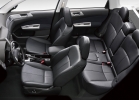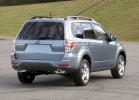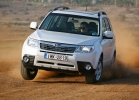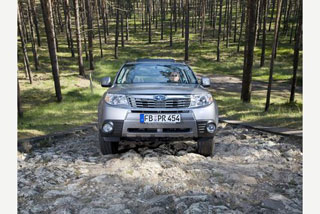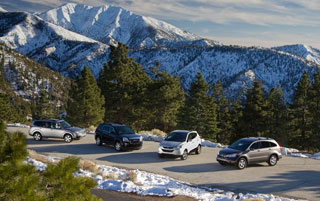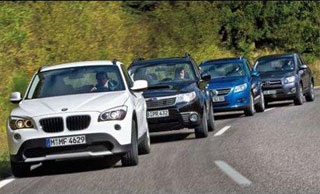Subaru Forester test drive since 2008 SUV
Subaru Forester test drive: System development
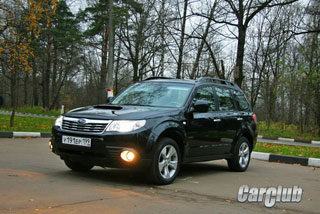 In December 2007, the world premiere of the new (third) generation of Subaru Forester, when creating which the developers decided to abandon their concept of an extra -class car and headed for a crossover.
In December 2007, the world premiere of the new (third) generation of Subaru Forester, when creating which the developers decided to abandon their concept of an extra -class car and headed for a crossover. With the release of the first generation of the first -generation of the station wagon, Subaru, the Subaru company occupied a certain niche in this, was only a nascent segment. Initially, the forester’s utility did not gain the proper popularity that the automaker was counting on. However, the development of the auto industry contributed to the fact that Subaru Forester has become one of the most popular cars in the classroom. An honest all -wheel drive, opposition engines and the leading positions of Subaru in motorsport became the main trumps of Forester.
In December 2007, the world premiere of the new (third) generation of Subaru Forester, when creating which the developers decided to abandon their concept of an extra -class car and headed for a crossover.
Following the first generation, the second appeared. Then the angular image of the Foreter acquired more rounded shapes, having received a portion of successful design solutions. As a result, the station wagon added driver qualities, became more powerful and prestigious. Further, the success of the Forester model began only to grow, the proof of which is its recognition by a car of the year in different countries of the world. And in December 2007, the world premiere of the new (third) generation Subaru Forester was held, when creating which the developers decided to abandon their concept of extra -class car and headed for the crossover.
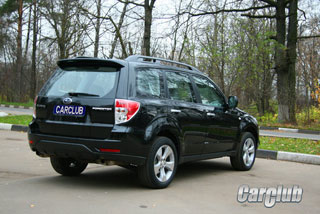 The new Forester acquired a completely different optics and received a different shape of the false radiator lattice. The image of the novelty has become more rounded and swift.
The new Forester acquired a completely different optics and received a different shape of the false radiator lattice. The image of the novelty has become more rounded and swift. The novelty has grown significantly in size: the body length increased by 74 mm and amounted to 4,560 mm; The forester added 45 mm in width, and now it is 1,780 mm; The height was 1,675 mm (an increase of 85 mm), and the wheelbase increased to 2 615 mm. Such external data are comparable to Toyota Rav4 and Honda CR-V, which automatically brought Subaru Forester to the crossover segment. Here the first contradictions arose. Someone will be happy to exclaim: finally they made a normal full-fledged crossover from Forester, and they will be right. However, on the other hand, with the release of the new generation, Subaru abandoned the interclass, which attracted many Forester fans who loved the combination of gambling passenia and inclinations of the rogue. Honestly, if you remove the nameplate with the name of the model and the predatory hole on the hood (in turbocharged versions), then I would never have thought that Subaru Forester was standing in front of me.
We open the door, and the first thing that catches the eye of the door framework. Danes of safety, nothing can be done, but a pity. Once the frameless doors were a distinctive feature of Subaru, and millions of fans loved these cars, including for this.
The forester of the last generation significantly added in size: the length of the body increased by 74 mm and amounted to 4,560 mm; The forester added 45 mm in width, and now it is 1,780 mm; The height was 1,675 mm (an increase of 85 mm), and the wheelbase increased to 2 615 mm. Such external data are comparable to Toyota Rav4 and Honda CR-V
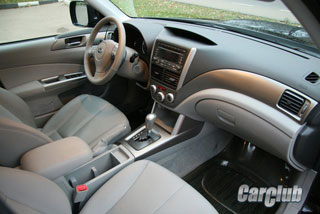 The interior has undergone noticeable changes that clearly benefited. There were more smooth lines and transitions that replaced the angular decisions of the previous generation. The steering column is adjustable both along the angle of inclination and by departure. The plastic used in the decoration panel is pleasant to the eye, and only after checking for a knock do you understand that it is actually made of hard plastics. A comfortable driver’s chair is equipped with an electric drive. To the left of the steering column, the Start/STOP button of the top -line execution prerogative appeared. The dashboard with a pleasant blue backlight sins too fine digiter. If it were not for the frankly cheap pens responsible for the control of the climate installation, and plastic painted for aluminum, then the interior of the new forever could give more pleasant impressions.
The interior has undergone noticeable changes that clearly benefited. There were more smooth lines and transitions that replaced the angular decisions of the previous generation. The steering column is adjustable both along the angle of inclination and by departure. The plastic used in the decoration panel is pleasant to the eye, and only after checking for a knock do you understand that it is actually made of hard plastics. A comfortable driver’s chair is equipped with an electric drive. To the left of the steering column, the Start/STOP button of the top -line execution prerogative appeared. The dashboard with a pleasant blue backlight sins too fine digiter. If it were not for the frankly cheap pens responsible for the control of the climate installation, and plastic painted for aluminum, then the interior of the new forever could give more pleasant impressions. The rear passengers, who have received a sufficient amount of free space, an armrest and convenient reciprocators with backlight, can truly evaluate the increased external dimensions.
The 230-horsepower Subaru Forester with an automaton shows a cheerful and powerful acceleration, which is accompanied by a noble roar of an opposition engine. Good traction begins already from the bottoms and does not disappear until the tachometer arrow reaches the maximum permissible revolutions. It is noteworthy that turbocharged versions are not equipped with electro-, but with a traditional hydraulic power steering. As a result, the steering wheel in these modifications is more informative with good reactive effort and feedback.
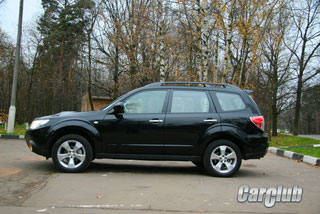 For a test drive, we got a Subaru Forester, equipped with a 2.5-liter with a capacity of 230 hp. The last generation of foresters, equipped with an atmospheric engine, is characterized by the presence of a DOHC gas distribution mechanism. Both a turbocharged and atmospheric engine can be aggregated by a 5-speed mechanics or a 4-band automaton. Those who chose the car on the handle will be appreciated by the Hill Start Assist system, which avoids the rollback of the car at starting in the hill.
For a test drive, we got a Subaru Forester, equipped with a 2.5-liter with a capacity of 230 hp. The last generation of foresters, equipped with an atmospheric engine, is characterized by the presence of a DOHC gas distribution mechanism. Both a turbocharged and atmospheric engine can be aggregated by a 5-speed mechanics or a 4-band automaton. Those who chose the car on the handle will be appreciated by the Hill Start Assist system, which avoids the rollback of the car at starting in the hill. The interior has undergone noticeable changes that clearly benefited. There were more smooth lines and transitions that replaced the angular decisions of the previous generation. In addition, finishing materials have improved, although plastic is still hard.
A new SI-Drive motor regulation system has also appeared, designed to improve efficiency without loss of dynamics. The 230-horsepower Subaru Forester with an automaton shows a cheerful and powerful acceleration, which is accompanied by a noble roar of an opposition engine. Good traction begins already from the bottoms and does not disappear until the tachometer arrow reaches the maximum permissible revolutions. Typically, a turbocharged and atmospheric version of a 2.5-liter engine, unlike a 2.0-liter engine, are equipped with a traditional hydraulic power steering. As a result, the steering wheel in the powerful modifications of the forester is more informative with good reactive effort and feedback.
With the growth of external sizes, the convenience for the rear passengers also increased. The leg space has increased significantly. Convenient cup holders with a pleasant backlight and an impromptu table appeared in the sofa pillow. For the top version, a non -cloth access system is available to the car and the engine start button, located to the left of the steering wheel.
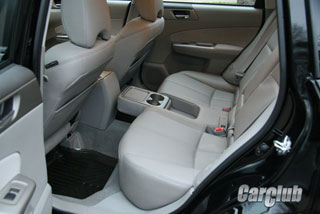 Despite the increased dimensions, the gambling features of the previous Subaru Forester are guessed in the handling of the last generation. Of course, due to the enlarged clearance, the rolls became much larger, but the forester enters the turn with the same excitement. If you overdo it with an accelerator, then Forester will respond with a frank sliding of the front axle, which, however, is easily extinguished by the discharge of gas. But now the suspension with increased moves swallows holes like seeds. On the primer, too, without problems. The vibrations from irregularities are calmly extinguished by the suspension, not having time to jump onto the body, and gambling allows us to enjoy the winding ground bends. However, it is more careful: if the front is to load the front in the bend, then Subaru fudishly wags the rear axle, ready to go into a classic skid.
Despite the increased dimensions, the gambling features of the previous Subaru Forester are guessed in the handling of the last generation. Of course, due to the enlarged clearance, the rolls became much larger, but the forester enters the turn with the same excitement. If you overdo it with an accelerator, then Forester will respond with a frank sliding of the front axle, which, however, is easily extinguished by the discharge of gas. But now the suspension with increased moves swallows holes like seeds. On the primer, too, without problems. The vibrations from irregularities are calmly extinguished by the suspension, not having time to jump onto the body, and gambling allows us to enjoy the winding ground bends. However, it is more careful: if the front is to load the front in the bend, then Subaru fudishly wags the rear axle, ready to go into a classic skid. Frankly cheap twists of the climate control spoil the positive impression of the interior decoration. The dashboard sins too small digitization. There are no complaints about the trunk - if you add the back row of seats, then the Forester will porn 1610 liters of useful volume.
The old kind four -band automatic transmission of Sportshift was finalized. As a result of switching, even smooth and faster occur. There are actually no delays in switching, but you can’t count on fuel efficiency. With frequent accelerations and quick overtaking, the four -speed layout of the transmission does not allow the tachometer arrow to leave the highest revolutions, which makes it increasingly glancing behind the presence of grief in the tank.
With the release of the new generation of the Subaru Forester model, the crossover segment was replenished with a strong beginner who is able to create a decent competition for class leaders. The new forester is characterized by good equipment, good controllability and an excellent all -wheel drive system, in which the torque on the axis is constantly transmitted and distributed through the differential with the WISKOFTA (in most crossovers, the all -wheel drive is made connected, which is not for the better, it affects controllability in the condition of the slippery road) .
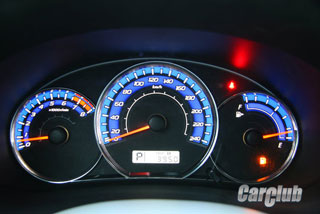 Despite the access to the Subaru Forester crossover segment, he remained faithful to the real full drive. With such a layout, the torque on the axis is constantly transmitted and distributed through the differential with the WISKOFTA (in most crossovers, the four -wheel drive is made connected, which is not for the better affects controllability in the condition of the slippery road).
Despite the access to the Subaru Forester crossover segment, he remained faithful to the real full drive. With such a layout, the torque on the axis is constantly transmitted and distributed through the differential with the WISKOFTA (in most crossovers, the four -wheel drive is made connected, which is not for the better affects controllability in the condition of the slippery road). Of course, it’s a little sorry that the good old Forester, who won so many fans, went to the secondary market. Indeed, often true fans of a particular brand or model are very conservative about the radical changes that the automakers prepared for them. However, in the modern world, progress cannot be inevitable. As one friend of mine said: if you had not a system, be its development.
Ruslan Galimov
+
Great engine and transmission
Honest all -wheel drive
-
Krains in corners
Non -informative dashboard
The price of the tested car is 1,303,600 rubles
Complete the test of the tested car
Symmetrical AWD permanent all -wheel drive
Central Castle (DU)
immobilizer
Wipers with electric drive
Rear -view mirrors with electric
Heating of the wiper zone
Rear -view mirrors
heating the front seats
climate control
Cruise control
6 airbags
Power steering
Steering wheel adjustment/departure
Stereosystem 6CD changer with a steering wheel control + 6 speakers + subwoofer
Washes of the headlights of hidden type
Fog lights
Near light xenon lamps
Alloy wheels R-17
Full -size spare wheel
Roof rails
EBD (system distribution system)
ABS
VDC (stabilization system of course stability)
Road lumen alignment system
Assistance system when touched from a place on the slope (for MT)
Leather upholstery of the salon
Panoramic hatch with electric drive
Driving driver electric drive
Rear door spoiler
Intelligent access system + engine start button
Specifications
Body
Type of body crossover
The number of places 5
Trunk volume, l 450/1610
Equipped mass, kg 1520
Complete mass, kg
Length, mm 4560
Width, mm 1780
Height, mm 1700
Wheel base, mm 2615
Road clearance, mm 225
Engine
Type of gasoline, horizontal and opposite, with turbocharged
The location in front is longitudinally
Location and number of cylinders 4 opposition
Working volume, cm 2457
Cylinder diameter/piston stroke, mm 99.5 x 79.0
Compression degree 8.4
The number of valves per cylinder 4
Maximum power, L.S./rpm 230/5200
Maximum torque, Nm/rpm 320/2800
Transmission
Gearbox 4-speed automatic
The drive is full, with the active distribution of torque
McPherson front suspension with a reptile stability stabilizer
The rear suspension is an independent two -winged with a stabilizer
Front brakes Disco ventilated
The rear brakes are disk
Tires 225/55 R17
Dynamics
Maximum speed, km/h 207
Acceleration time 0-100 km/h, with 7.9
Fuel consumption, l/100 km
city cycle 14.5
country cycle 8.2
mixed cycle 10.5
Fuel tank capacity, l 60
Fuel AI-95 gasoline
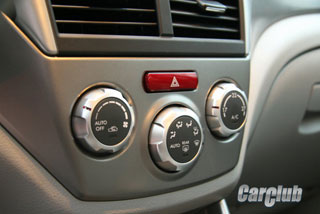
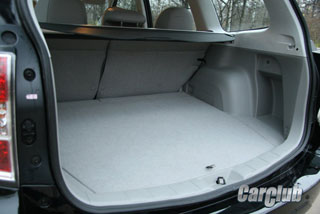

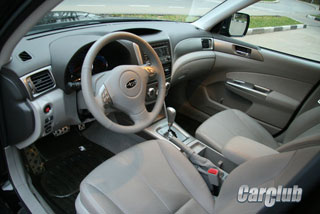
Source: Carclub.ru
Video Subaru Forester test drive since 2008
Subaru Forester Crash Video since 2008
Subaru Forester test drive since 2008
Subaru Forester Crash Test since 2008
Krassh Test: Detailed Information91%
Driver and passengers
73%
Pedestrians
91%
Children-passengers
86%
Active security system


